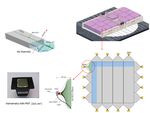Progress of Veto Detector of JUNO - Journal of Physics: Conference Series - IOPscience
←
→
Page content transcription
If your browser does not render page correctly, please read the page content below
Journal of Physics: Conference Series
PAPER • OPEN ACCESS
Progress of Veto Detector of JUNO
To cite this article: Peng Zhang 2020 J. Phys.: Conf. Ser. 1468 012188
View the article online for updates and enhancements.
This content was downloaded from IP address 46.4.80.155 on 15/01/2021 at 14:29TAUP 2019 IOP Publishing
Journal of Physics: Conference Series 1468 (2020) 012188 doi:10.1088/1742-6596/1468/1/012188
Progress of Veto Detector of JUNO
Peng Zhang
Institute of High Energy Physics, Chinese Academe of Sciences, Beijing, China
E-mail: zhangpeng3@ihep.ac.cn
Abstract. The Jiangmen Underground Neutrino Observatory (JUNO) is a 20 kiloton liquid
scintillator detector with neutrino mass hierarchy determination as primary physics goal.
The other measurements, including precise neutrino oscillation parameters, solar neutrino,
geo-neutrino, supernova neutrinos and the diffuse supernova neutrinos background, will be
performed at the same time. The detector will be built in a 700 meter deep underground
laboratory. A multi-eto detector, composed of a Top Tracker and a Water Cherenkov, will be
installed for cosmic muon detection and background reduction. The Top Tracker detector is
placed above the central detector, and is composed of three layers of scintillating strips. The
outer part of the Central Detector is filled with water and equipped with about 2400 MCP-
PMTs (20 inches) to form the Water Cherenkov detector used for muon tagging. Thanks to the
Veto detector, the cosmic muon induced fast neutron background can be reduced to a level of
about 0.06/day.
1. The JUNO experiment
The Jiangmen Underground Neutrino Observatory (JUNO) [1] is a multipurpose neutrino
experiment designed to determine neutrino mass hierarchy and precisely measure oscillation
parameters by detecting reactor neutrinos from the Yangjiang and Taishan Nuclear Power
Plants, observe supernova neutrinos, study the atmospheric, solar neutrinos and geo-neutrinos,
and perform exotic searches, with a 20-thousand-ton liquid scintillator detector of unprecedented
3% energy resolution (at 1 MeV) at 700 meter deep underground. The JUNO detector includes
the Central Detector (CD), Veto detector and other systems [1, 2], shown in Fig. 1. The
Veto system is composed of a Water Cherenkov Detector (WCD) and a Top Tracker (TT) to
study and reduce muon induced background. This paper will mainly introduce the design and
construction of Top Tracker and Water Cherenkov Detector.
2. Top tracker
The Top Tracker is a 3-layer muon tracker over the JUNO water pool, whereby it covers about
60% of the pool top and detects 1/3 of muons crossing the CD. It consists of 63 6.8 x 6.8 m2
square walls made of plastic scintillator strips, taken directly from the OPERA experiment [3].
The walls are divided into 3 layers, and every layer of walls are arranged in 3 row and 7 columns.
The wall consist of eight modules and each module contains 64 scintillator strips read by two
64- channel multianode photomultiplier tubes (PMTs) at both of ends. The schematic view of
Top Tracker is shown in Fig. 2.
Content from this work may be used under the terms of the Creative Commons Attribution 3.0 licence. Any further distribution
of this work must maintain attribution to the author(s) and the title of the work, journal citation and DOI.
Published under licence by IOP Publishing Ltd 1TAUP 2019 IOP Publishing
Journal of Physics: Conference Series 1468 (2020) 012188 doi:10.1088/1742-6596/1468/1/012188
Figure 1. A schematic view of the JUNO Figure 2. A schematic view of Top Tracker.
detector.
3. Water Cherenkov Detector
The Water Cherenkov Detector consist of 2400 20 inch MCP-PMTs surrounding the CD and of
35 kton pure water in a water pool. The pool is a cylinder with a diameter of 43.5 meters and a
depth of 44 meters covered with a layer of HDPE film. In order to keep water highly tranparent
and an uniform temperature and prevent radon diffusing to CD, a ultra pure water circulation
system with radon removal function will be built, shown in Fig.3. The PMT arrangement,shown
in Fig.4, was optimized to make muon detection efficiency above 95%, detecting tracks with a
good resolution. Since the 20 inch PMTs collection efficiency is affected by the earth magnetic
field intensity, a earth magnetic field shielding system consisting of 16 pairs shielding coils is
developed to generate a magnetic field opposite to the direction of geomagnetic field, which can
reduce magnetic field to be below 10 µT in the spherical region with a radius of 37.5 m, shown
in Figure 5. Both of the surface of this CD and water pool are covered by Tyvek film to increase
the light detection as shown in Fig.6.
Figure 3. A schematic view of the JUNO detector.
2TAUP 2019 IOP Publishing
Journal of Physics: Conference Series 1468 (2020) 012188 doi:10.1088/1742-6596/1468/1/012188
Figure 4. PMT arrangement of WCD.
Figure 5. Earth magnetic field shielding
system.
Figure 6. Tyvek film coverage area of WCD.
4. References
[1] An F, An G, An Q, et al. Neutrino physics with JUNO[J]. Journal of Physics G: Nuclear and Particle Physics,
2016, 43(3): 030401.
[2] Adam T, An F, An G, et al. JUNO conceptual design report[J]. arXiv preprint arXiv:1508.07166, 2015.
[3] Acquafredda R, Adam T, Agafonova N, et al. The OPERA experiment in the CERN to Gran Sasso neutrino
beam[J]. Journal of Instrumentation, 2009, 4(04): P04018.
3You can also read
























































